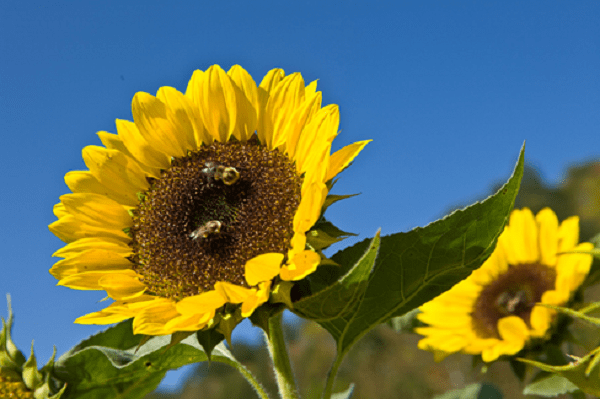The sunflower has a rich history as a North American native plant. Records show that as early as 3000 B.C. Native Americans cultivated sunflower as food and pressed seeds to make oil. Although still used for these purposes today, gardeners also employ sunflowers (Helianthus spp.) as ornamentals, either in the landscape or as cut flowers, and to attract birds or squirrels.
Breeding has also developed varieties that range from 15 inches to 12 feet in height and colors of yellow, white, red, and bronze. This selection gives even the smallest garden a chance to grow a sunflower. Dwarf varieties including ‘Pacino’, ‘Big Smile’, and ‘Music Box Mix’ are bushy, with multiple flower heads on each stem, and grow less than 3 feet tall. These are great for planters or mixed borders.
If you have more space, try growing the 8 feet tall H. bismarkianus, and H. citrinus, or the 12 feet tall H. giganteus as a background screen. As a bonus, the taller varieties generally offer the widest color palette. Sunflowers also make great cutflowers. Because they produce plentiful pollen, some pollenless varieties including ‘Moonbright’, ‘Sunbright’, and ‘Sunrich’ make great selections. Other favored varieties, regardless of the pollen shed, include ‘Velvet Queen’, ‘Autumn Beauty Mix’, and ‘Italian White’. Double-flowered varieties like ‘Lion’s Mane’, ‘Teddy Bear’, and ‘Tohoku Yae’ are favored for bouquets. Though all these produce seeds, confectionery types, ‘Mammoth’ being the most often used, is recommended for edible seeds.
Sunflowers require only a few basic needs for growth: well-drained soil, water, fertilizer, and weeding. Seeds can first be planted in the spring when soil temperatures reach 42 to 50 degrees F and air temperatures above 50 degrees F. Depending on variety and the environment, germination should occur in 7 to 12 days. Plant your seeds in a full sun site. Thin seedlings to 3 feet apart for giant and 1 foot for dwarf varieties.

Keep the soil moist during germination. Sunflowers need a regular application of low nitrogen fertilizer from germination through the development of the flower head. As a general recommendation, apply about a cup of 5-10-10 per 50-foot row every two to three weeks. Sunflowers will mature between 65 to 90 days. After plants are established they are generally very drought resistant, however, they must receive adequate water during their critical seed development period about 20 days before and after flowering. If rainfall is lacking, supplement water during this period.
Sunflower heads are ready for fall harvest when the florets in the center of the disk are shriveled, heads are downturned, and the back of the head turns greenish-yellow to yellow. Pull a few seeds from the center of each head and split them open to check if the meat has filled. If the heads are ready, cut the seed head leaving about a foot of stalk attached. Cover the seed head in cheesecloth and hang upside down in a warm, protected place with low humidity. Allow the heads 3 weeks to dry.
Directing a fan toward the heads may speed up the drying time. Seeds are ready to store when the back of the head turns dark brown. Remove the seeds by rubbing two heads together or by rubbing your palm across the seeds. Store the seed in well-tied bags as jars and tins may encourage mold development.
If you are growing sunflowers for wildlife, you can keep the seeds in the head, and during the winter months, nail dried heads to a post to create an instant feeding station.
Interested in learning more about gardening? Why not join the Master Gardener Program. Training in Christian County starts September 13. Contact the Christian County Extension Office for an application at 270-886-6328.
— Kelly Jackson, Christian County Extension Agent





